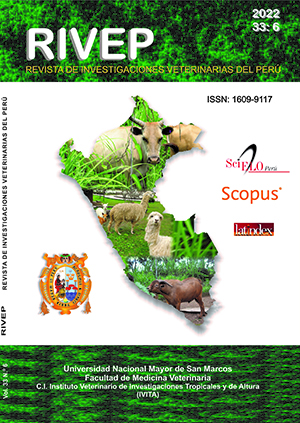Two protocols to synchronize the oestrus of lactating ewes using progestogens
DOI:
https://doi.org/10.15381/rivep.v33i6.24095Keywords:
lactating sheep, temporary weaning, synchronization protocol, short, conventionalAbstract
The aim of this study was to evaluate two protocols for oestrus synchronization using intravaginal progestogens. In the study, 64 ewes with lambs at foot of 30-40 days old were used. The animals were assigned to two groups: (T1): application of a short synchronization protocol (6 days) with suppression of suckling for 30 hours (n1=32) and (T2): application of a long or conventional protocol (12 days) with suppression of suckling for 54 hours (n2=32). Fixed-time artificial insemination (FTAI) was performed with refrigerated semen through the transcervical route at the end of temporary weaning. The pregnancy rate without heat return at 16-17 days post-FTAI, pregnancy rate at 41 days by ultrasound, pregnancy rate at 90 days by balloting and type of delivery were determined. The rate of non-return to oestrus at 15-17 days post-FTAI was 81.25% for T1 and 87.50% for T2 (p<0.05). Likewise, the pregnancy percentages by ultrasound and by balloting were statistically similar between treatments. The twin birth rate was slightly, but not significantly different in T2 (26.92%) than in T1 (19.2%). The results show that when applying a short synchronization protocol, similar results are achieved as when applying the conventional synchronization protocol and with the advantage that it is carried out in less time.
Downloads
Downloads
Published
Issue
Section
License
Copyright (c) 2022 Saúl Espinoza Molina, Gabriela Espinoza Rojas, Chessyra Ticona Huaroco, Mario CCari Huayta, Uri Harold Pérez Guerra, Danny Julio Cruz

This work is licensed under a Creative Commons Attribution 4.0 International License.
AUTHORS RETAIN THEIR RIGHTS:
a. Authors retain their trade mark rights and patent, and also on any process or procedure described in the article.
b. Authors retain their right to share, copy, distribute, perform and publicly communicate their article (eg, to place their article in an institutional repository or publish it in a book), with an acknowledgment of its initial publication in the Revista de Investigaciones Veterinarias del Perú (RIVEP).
c. Authors retain theirs right to make a subsequent publication of their work, to use the article or any part thereof (eg a compilation of his papers, lecture notes, thesis, or a book), always indicating the source of publication (the originator of the work, journal, volume, number and date).










